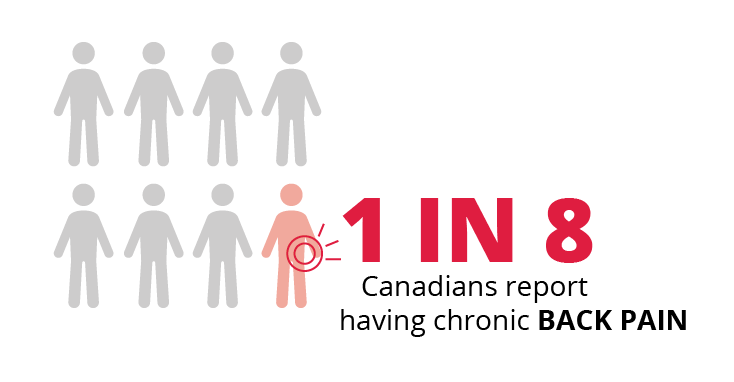For Employers and Insurers
Are your employees among the 4.7 million Canadians who benefit from chiropractic services each year?


Download Now: “The Rise of a Static Workforce & the Critical Role HR Plays in Tackling the Most Common Injury”
Labour demands are high, and there has never been a more important time for companies to nurture healthy, productive workers. But with the rise of hybrid work environments, a confluence of trends is pointing to the growing occurrence of neck and back conditions among employees.


We want to support your team’s MSK strategy by sharing our expertise.
Contact our Director of Professional Practice Dr. Crystal Draper at CDraper@Chiropractic.ca to discuss a free workshop tailored to your workplace needs.


Musculoskeletal conditions are the largest burden of illness on the economy in Canada and the second-largest source of workplace absenteeism in North America.




The Canadian workforce is changing as an aging population retires and birthrates continue to decrease. In addition to measures to attract a quality workforce, Canadian organizations must invest in keeping their teams active and productive.
Retaining healthy, working employees has become a priority for most employers, and providing extended health care benefits to supplement provincial coverage provides access to care and wellness programs designed to maintain optimal health.
Chiropractors, as primary contact providers, can play a significant role in improving organizational health and productivity, while reducing absenteeism and disability. Prioritizing best and appropriate care for employees will enable organizations to meet plan members’ needs while managing costs.
Why does your business need extended healthcare benefits for chiropractic care?


- Over 11 million Canadians suffer from low back pain each year1.
- Musculoskeletal conditions alone accounted for 10.3% of the total economic burden of all illnesses2, including direct costs (i.e., treatment and rehabilitation) and indirect costs (i.e., lost productivity).
- Back pain results in one third of all lost time and has a direct impact on productivity3,4.
- Workers’ compensation figures suggests that employees with low back pain treated by a chiropractor returned to work faster with reduced rates of chronic problems5,6.
- Introducing chiropractic services to innovative model of care across Canada has demonstrated the value of the care offered.
- 23% of employees want to use more paramedical benefits to help manage their chronic conditions.7
“Including chiropractic referrals in our collaborative practice model appears to be reducing return-visits to the physicians for neck and back pain and other musculoskeletal conditions. We are also seeing the potential for a decrease in emergency department visits for acute back pain and less need for specialist level consults. This type of innovation translates to improved quality of care and significant cost-savings for Canada’s health care system.”
Dr. Deborah Kopansky-Giles, DC, Chiropractic Program Coordinator at St. Michael’s Hospital.
Education and regulation
The core curriculum prepares Canada’s 9,000 licensed chiropractors to be experts in the musculoskeletal and neurological system.
Not all paramedical practitioners are the same. The four-year globally accredited doctoral program focuses on building expertise in the assessment, diagnosis, management and prevention of conditions of the musculoskeletal system and associated neurological system, which includes over 4,200 hours of clinical education and a 12-month clinical internship.
Doctors of Chiropractic are regulated in every province across Canada, and are trained as primary care professionals to assess, diagnose, manage (or refer if necessary) and treat conditions.
Adequate Coverage
Two-thirds of Canadians who are experiencing pain stated that if they could afford to pay for more of the available treatments offered, their discomfort and quality of life would be improved8.
Ensuring adequate coverage for paramedical services is an important step towards removing financial barriers for employees accessing the care they need.
Paramedical benefit maximums across the sector have remained static for over two decades, falling far behind inflation and the cost of doing business. In the US, Medicare covers an unlimited number of medically necessary chiropractic visits9. Like any small business, the cost of operating clinics for extended health professionals has increased. The result is that plan members access less care than they were able to five or ten years ago.
1. Canadian Orthopaedic Care Strategy Group. (2010). Building a Collective Policy Agenda for Musculoskeletal Health and Mobility.
2. Canadian Institutes of Health Research. Investing in Canada’s Future 2004-2005: Arthritis. Ottawa: CIHR; 2012 [updated 23 November 2006, 3 July 2012]; Retrieved from www.cihr-irsc.gc.ca/e/documents/arthritis_mpkit_2005_e.pdf.
3. Cleland, J. Childs, J. Frtiz, J. Emberhart, S. Development of a clinical prediction rule for guiding treatment of a subgroup of patients with neck pain: use of thoracic spine manipulation, exercise, and patient education. Physical Therapy.2007 Jan;87(1):9-23
4. Lutteman, A., Jager, M., Griefahn, B. Preventing musculoskeletal disorders in the workplace. Protecting Workers’ Health Series No. 5.2003
5. Nyiendo, J. (1991). Disabling Low Back Oregon Workers’ Compensation Claims Part II: Time Loss. JMPT, 14(4): 231-239.
6. WSIB. (2004). Program of Care for Acute Low Back Injuries One-Year Evaluation Report.
7. Benefits Canada, 2022 Benefits Canada Healthcare Survey, 2022.
8. Angus Reid, One-in-five report living with significant chronic pain, most say they’d be better off if care more affordable, July 12, 2019.
9. United Health Care, Does Medicare cover a chiropractor? https://www.uhc.com/news-articles/medicare-articles/does-medicare-cover-a-chiropractor.